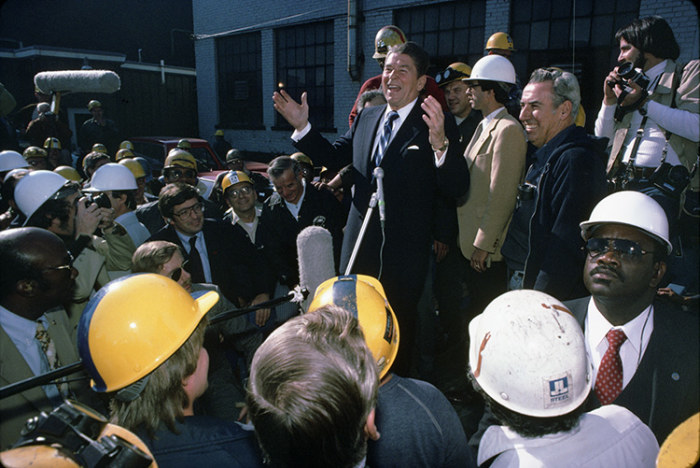Dan Guild: Donald Trump’s presidency is defined by the stability of its unpopularity, and elections with incumbents are defined by perceptions of their job approval. -promoted by Laura Belin
I wrote at Crystal Ball in April that elections with incumbents are defined by perceptions of their job approval. In a post for this site in July, I suggested that Trump’s approval, and the sense across the country that things were out of control, reminded me of the difficulties that Jimmy Carter faced in his re-election.
On the eve of the election I find myself thinking about the parallel to 1980 again.
Here is the simple data. Donald Trump’s job approval never got over 50 percent in an average. His presidency is defined by the stability of its unpopularity–though in fairness, he never reached the lows of Carter. This the chart of Trump’s approval at FiveThirtyEight.com. It is remarkable. There has never been anything like it in the history of American politics.
The problem: a president’s job approval determines his re-election chances. It is astonishing how well the line fits in this graph. If you take Trump’s current job approval rating, the formula predicts Trump will receive 44.6 percent of the vote.
There has been some evidence that this president’s re-elect numbers are about 2 points higher than his approval numbers in pre-election polls. If so he would project to 46.24 percent of the vote.
The size of Joe Biden’s victory will therefore depend on how well he consolidates the vote of those who disapprove of Trump. My guess is about 2 percent will vote for third-party candidates, and I think the general election vote will look like this:
Trump: 46 percent
Biden: 52 percent
All other candidates combined: 2 percent
While this will not come as a surprise to those who follow polling, it will be a surprise to the average American. Polling says Americans are expecting a close race.
And as I wrote in June,
What is difficult to explain to those who have no memory of 1980 is how shocking the results were. It was not just that Reagan won, but that Republicans took control of the U.S. Senate for the first time in decades. The GOP picked up twelve Senate seats, beating some well-liked Democrats with national reputations.
Anthony Lewis, perhaps the most prominent liberal columnist for the New York Times at the time, wrote two days after that election, “The Senate results make the point even more compellingly than Ronald Reagan’s electoral vote landslide: what happened in the 1980 election reflected a profound and general turn to conservatism in this country.
Honestly, the election day drama will center on the Senate races. That is where the longer term effects of this election are likely to be decided. I don’t think there is serious doubt Biden is going to win the presidency. But there is very real uncertainty about the Senate.
This table sorts the competitive seats by Trump’s disapproval. The key thing to note is that other than in Maine, the GOP candidate virtually never receives more vote than Trump’s job approval in that state. In this sense Trump is acting very much like a ceiling for Republican Senate candidates.
The other thing worth noting here is that many of the most hotly contested seats are being fought on relatively friendly territory for the GOP. Trump’s national job approval is 43.61 in this data set. The Democrats are favored in both Maine and Colorado, where Trump is intensely disliked.
The real battlegrounds will be in states like Iowa, Georgia, North Carolina, and Montana, where hard-fought Senate campaigns are being waged on supposedly Republican ground. Democratic wins in any of these seats would create shockwaves larger than the presidential election itself.
One final note: in April, commentators began to notice Trump’s unpopularity with those over age 65. I had meant to write about this. I investigated, and to my surprise Trump’s problems with seniors began before the COVID-19 pandemic.
The data show that for some time, Trump has had a problem with a group he won in 2016. What is interesting is how little it was noticed, and how often the shift is attributed to COVID, even though the pandemic clearly did not cause the change.
Top photo: Ronald Reagan campaigning in Youngstown, Ohio on October 8, 1980. Photograph from the Ronald Reagan Presidential Library collection, available via Wikimedia Commons.





1 Comment
Some of us will be watching Iowa Leg races just as intently as the national races...
…and hoping deeply that the Iowa House will flip. The possibility of two more trifecta years is awful to contemplate.
PrairieFan Tue 3 Nov 1:56 AM